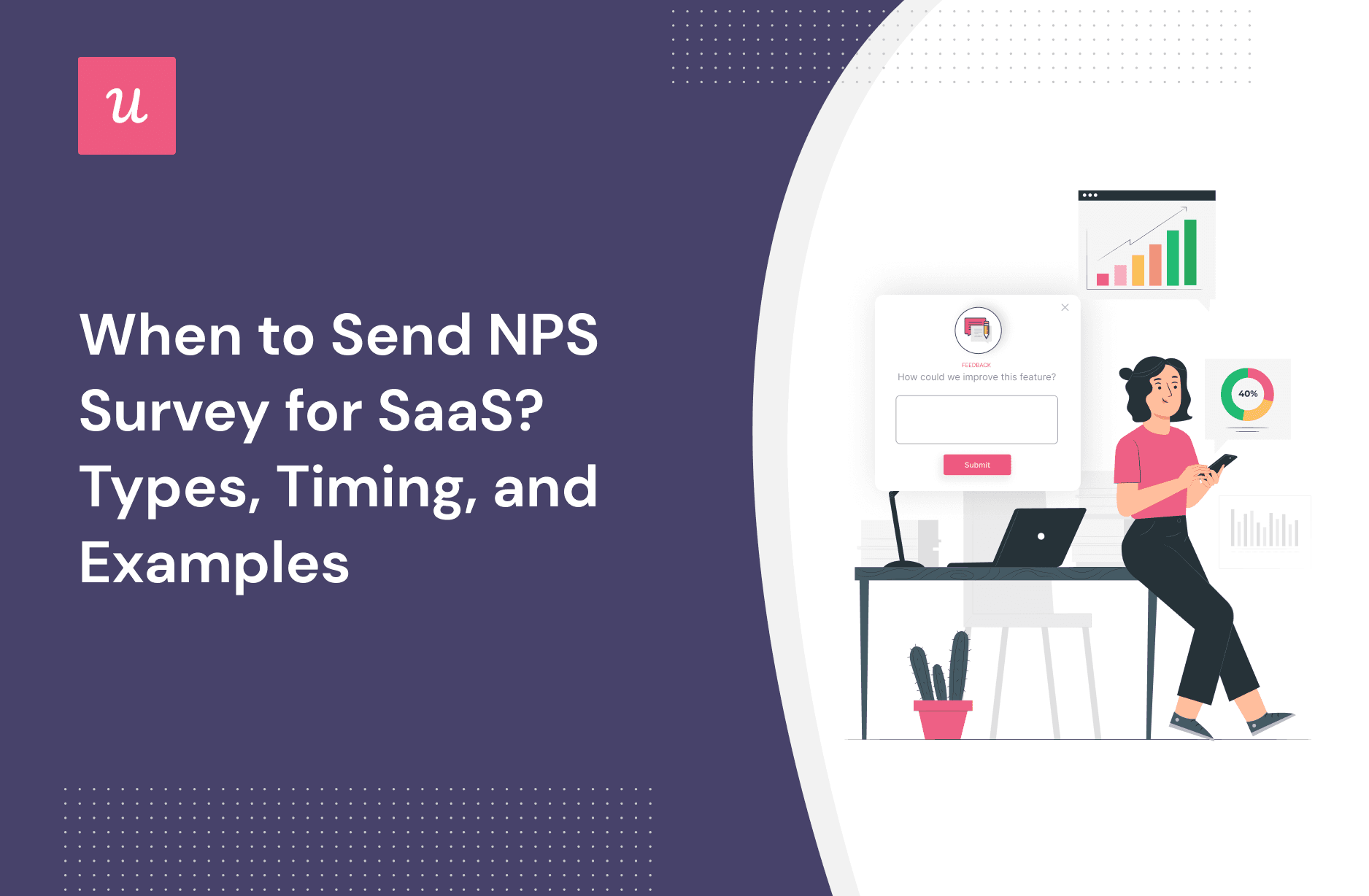
In SaaS, your customer’s opinions and experiences determine your success. With NPS surveys, you can gauge your customer’s overall sentiment and identify improvement areas.
But when is the right time to send a Net Promoter Score survey? Should you send it after onboarding or immediately after a feature release? What about after a customer has churned?
In this article, we’ll dive into the different types of NPS surveys, the best timing for each, and provide examples to help you receive healthy response rates.
Try Userpilot Now
See Why 1,000+ Teams Choose Userpilot

What are the different types of NPS surveys?
NPS surveys aren’t made equal. They’re two different types you should apply in your NPS program (and yes, the timing for them is also different), and they include:
- Relational NPS surveys. Which are run continuously, asking customers the NPS question regularly (i.e annual or quarterly basis). It also helps you stay in touch with long-term customers to measure customer loyalty.
- Transactional NPS surveys. These are triggered based on events in the customer journey, such as after a purchase or closed support ticket. They’re important for measuring customer experience after these milestones, so you can make improvements if needed.
Relational NPS surveys
NPS surveys typically ask customers to rate their likelihood of recommending the company or brand to a friend on a scale of 0-10. Where scores of 9-10 are considered “promoters,” scores of 7-8 are considered “passives,” and scores of 0-6 are considered “detractors.”
Relational NPS surveys measure customer satisfaction after establishing a relationship with customers.
Its goal is to track changes in customers’ sentiment toward your product and identify areas for improvement (missing features, bugs, bad customer service, etc.).

Transactional NPS surveys
Transactional NPS surveys are sent after a specific interaction or transaction with a customer, such as after they request assistance from customer support.
These surveys measure satisfaction with a specific touchpoint and can provide insights to improve customer experience.
Also, since transactional surveys are more granular, you should keep the surveys short and sweet, with targeted questions that efficiently gather the specific information you need.
When should you send an NPS survey?
Well-timed and customized NPS surveys can significantly improve user experience and response rates, and prevent survey fatigue.
However, the best timing for your NPS surveys will depend on their type and purpose.
When to send relational NPS surveys?
The purpose of relationship NPS surveys is to keep tabs on your customers and check your customer loyalty levels on a timely basis. Which means they must be sent regularly.
To avoid survey fatigue, you should send a survey automatically every three, six, or even twelve months – giving enough space for your customer relationships to evolve between these periods and ensuring that users will reply transparently.
When to send transactional NPS surveys?
Since transactional NPS surveys measure satisfaction with specific touchpoints throughout the entire customer journey, the best timing is immediately or within seven days after the interaction or milestone has happened.
For example, if you’re tracking NPS with your onboarding process, you want to send the survey shortly after the user reached the activation stage.
This timeframe guarantees that the feelings and emotions of the customer are still fresh, making their feedback more reliable and accurate. Plus, it shows that you value your customers’ opinions and actively try to improve their experience.
5 NPS survey timing examples in SaaS
As said earlier, timing is crucial to receive a significant NPS response rate.
So, let’s explore some NPS survey timing examples for different scenarios, including:
- Sending relational surveys annually.
- Triggering surveys during the onboarding process.
- Tracking NPS after the free trial.
- Survey customers after a customer service interaction.
- Using NPS surveys to measure satisfaction with new feature releases and big updates.
Send relational surveys on an annual basis
Use relational NPS surveys to measure overall customer satisfaction each year to identify trends and variations.
However, the fact that it is annual doesn’t mean you should send long and complex surveys. For example, you can see below that Sonic.net annual surveys only take one click to complete.
We recommend sending this survey on the same day each year and keeping the questions consistent to ensure accuracy in tracking changes. Also, feel free to combine open-ended and closed-ended questions to gather both qualitative and quantitative feedback.

Trigger transactional NPS surveys during the onboarding process
To measure post-purchase satisfaction, consider sending a transactional NPS survey during onboarding. This way, you can collect feedback on the onboarding experience and take action when opportunities for improvement are identified.
For example, you could follow up with detractors to check what’s wrong, help them with their problems, and close the feedback loop. This shows customers that their opinion is valued and might even prevent churn.

Collect NPS survey responses after the free trial is over
With NPS surveys, you can also measure customer sentiment about their free trial experience. For example, you could trigger NPS surveys to new signups whose onboarding checklist is in progress (like in the image below).
This way, users who become paying customers can provide insights into what worked well, thus allowing you to double down on those elements. While those who opt out can reveal what was lacking and help you spot opportunities to improve customer retention.

Trigger transactional NPS surveys after customer service interactions
As explained earlier, you can send a transactional NPS survey after any customer interaction—including support service.
So, try setting up an automatic NPS survey to trigger right after a ticket is solved or a chat is closed (like the example in the image below). This way, you’ll be able to gauge user sentiment with your customer service.
Then use meaningful feedback to rate your support agent’s effectiveness, and the quality of your customer service process, and find common problems you can address in your knowledge base.

Send transactional NPS surveys after feature releases or product updates
Validating new features can be tricky. Thus, it is a good idea to schedule product NPS surveys after big product updates, so you can see how receptive your user base is to the changes and make improvements.
Also, you can use a tool like Userpilot to make sure to trigger surveys to active users only (like the screenshot below) and be able to analyze NPS responses accurately.

How to build and send NPS surveys with Userpilot?
Although you could send NPS surveys without any tool, we believe it’s way more convenient for user feedback software (like Userpilot) to test ideas on the go without having to code or rely on your dev team.
So, here’s how you can build and send NPS surveys with Userpilot in four steps:
- Add NPS survey content and follow-up questions.
- Customize NPS survey designs to match native themes.
- Set the target audience and frequency for sending NPS surveys.
- Analyze NPS responses using NPS response tagging.
Add NPS survey content and follow-up questions
Userpilot has a section dedicated to NPS surveys. Here, you can quickly build your Net Promoter Program, create surveys, and configure it.
You can also add and edit as many questions as you want, as well as trigger follow-up questions depending on your user’s score. Plus, any change you make is completely visible in the preview, so you can ensure your surveys look neat.

Customize NPS survey designs to match native themes
If you were worried about the design of your surveys, fear not.
Without coding, you can customize the colors and fonts, and even add your company logo to design NPS surveys consistent with your brand and product’s UI.
The process is simple:
- Choose the same color palette from your brand guidelines.
- Import your logo.
- Take the same font as your app.
No need to learn CSS and HTML to do this.

Set target audience and frequency for sending NPS surveys
After crafting and designing your survey, you can configure it to target a specific audience, including users who match behavioral conditions or user segments you created with Userpilot.
When your user base is properly segmented, you’ll get great response rates if you target the right survey to the right customers.

Then, set up the frequency. For relational surveys, here’s where you can schedule them to appear every 3 or 6 months. As well as re-trigger the survey a few days later when the user hits “ask me later,” among other functions for sampling and survey behavior.

And to capture feedback wherever your users are, trigger these NPS surveys directly within your mobile app, extending your reach to on-the-go users.
Bonus: Analyze NPS responses using NPS response tagging
Additionally, Userpilot is a unique NPS tool. It allows you to tag NPS responses and group customers based on those tags.
This is a very powerful feature because, once you’ve gathered enough data, you can quickly identify recurrent themes that your audience is talking about (whether positive or negative) and address them. For instance, if “customer support” is a common keyword used by detractors, you know there’s something to fix there.
You can quickly find your NPS tags by clicking the “tag” tab on your NPS dashboard.

Conclusion
The timing of your NPS surveys can make all the difference in the world when it comes to receiving healthy response rates. By understanding when to send relational and transactional surveys, you can receive more accurate and actionable customer feedback.
Thankfully, you can start sending NPS surveys in minutes with the right tools. So why not try a Userpilot demo and take your customer success and product team to the next level today?






